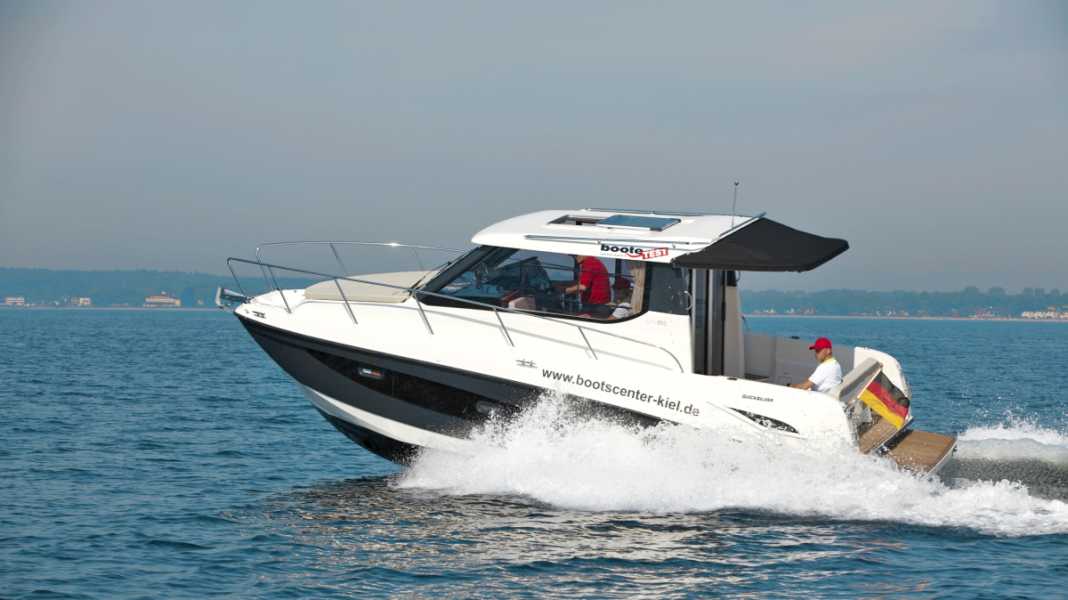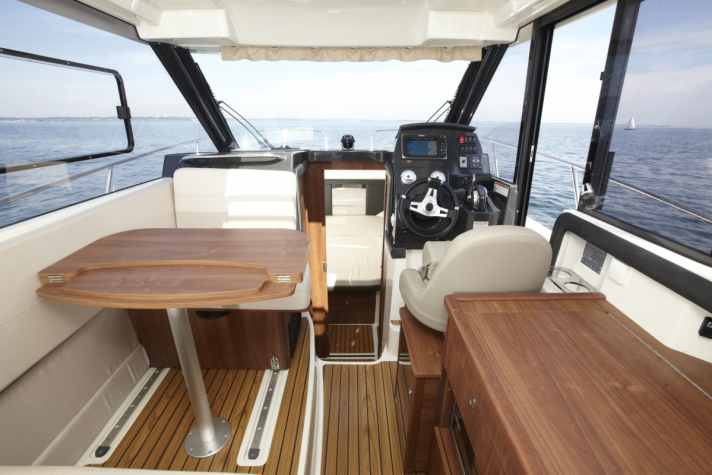Test: Quicksilver Activ 855 - Active holidays: On tour with the Quicksilver Activ 855
Ralf Marquard
· 08.08.2015








Quicksilver attracted attention with its newly launched Activ series at the Düsseldorf trade fair in 2011, when the shipyard won the title of "European Powerboat of the Year" with the Activ 675 Open. This honour was the result of a consistent new start for the line. In other words, not only has an old model been refreshed, but a truly new model series has been developed. There are now 14 variants in the Open, Sundeck, Cabin and Cruiser versions.
We travelled on the flagship, the Activ 855 Cruiser, a boat with six berths, galley and wet room, which also allows longer trips with its category B certification. However, if you want to head for the island of Bornholm, for example, you have to be able to rely on the shipyard's boatbuilding skills.
Here, Quicksilver relies on hand-laminated hulls "made in Poland" - good quality now comes from Polish factories. With the exception of a few details, this also applies to our test boat. We noted the unpainted inner sides in the corners of the engine compartment, where some laminate tips were visible or screws that had been "choked" through crooked holes.
Driving and manoeuvring
Brunswick has come up with a variety of engine options: single and twin engines with outboards and single inboard versions with petrol engines and a diesel version. The fact that we are travelling with the latter is particularly noticeable at low engine speeds, as the diesel engine (Die-sel) causes the boat and fittings to vibrate quite a bit. A characteristic that ceased on our test boat above 1000 rpm - which is the case at 1200 rpm in fast displacement cruising (6.5 knots).
In this situation, as well as at harbour speed (650 rpm), the Quicksilver yaws a little and sometimes wanders to one side, which has to be corrected slightly from time to time - not unusual for this type of boat. The transition from displacement to planing is around 1700-2800 rpm. This phase is not particularly lively, and the full-throttle run shows us one reason for this: the diesel only reached a maximum speed of 3500 rpm, but according to the Mercury diesel, its optimum "maximum speed" is 4000 rpm. A sign that the 21" twin propeller is at least one size too big.
A correctly adjusted propeller not only protects the engine from excessive loads, but also improves the tracking behaviour. - But back to the actual situation: To maintain foresight during the transition phase, the power trim should be moved to the transom and the trim tabs (extra) moved down. The faster the glide then becomes, the further the trim tabs can be raised and finally the power trim can be raised slightly. When it comes to fast cruising (23.5 knots), the diesel engine plays its trump card: With a fuel consumption of 1.51 l/sm and a tank capacity of 400 litres minus 15% reserve, this results in a respectable range of 224 nm, which is roughly equivalent to the distance Lübeck-Bornholm and half back.
It is impossible to say how the hull will cope with the waves, as the Baltic Sea off Neustadt was calm on the test day. Good conditions for assessing fast manoeuvres: On slalom courses, the Quicksilver rocks powerfully but always safely over its longitudinal axis. If you jerk the steering wheel, the stern sets in with determination. In fast roundabouts, the boat lies normally on the inside of the bend, and if you turn very sharply, the bow goes down a little and the hull goes sharply round the bend with a jerk - which requires good holding.
The driver sits on a bucket seat with firm cushions. Passengers can sit on the variable bench seat, which can either be used as a saloon bench or folded down as a passenger bench. In the latter variant, you hold on to a handle directly on the driving position. The instrument panel is arranged high up on the side, making everything easy to read. This only applies to the compass to a limited extent, as it is located in the centre of the driver's platform in the middle above the companionway and can therefore only be read if you lean to the side. The advantage of this arrangement is that other instruments cannot distract it.
Engine, tank, electrics
Depending on how the rear bench seat is positioned in the cockpit, the front or rear area of the engine compartment can be opened. This allows access to all corners of the engine - even if only on alternate sides. The boat builders laid the cables and hoses with clamps and cable ties. The shut-off valve and extra diesel filter with drain plug are particularly impressive features of the fuelling system. The partial fastening of the fuel hoses with just one screw clamp is not convincing. Two 55 Ah Optima batteries provide the 12 V power supply and are switched via a selector switch on the pantry block. There is also an easily accessible 12 V automatic panel. The 230 V distribution with fuses and RCD for the shore connection (extra) is located on the driver's seat.
Security
The fire extinguishing system in the engine compartment and the self-extinguishing sound insulation covered with foil deserve praise. Two standard electric bilge pumps provide comfort, but if the power supply fails, only a manual bilge pump can help to pump the water back outboard in the event of a leak. No such pump is available.
To get safely from the cockpit to the foredeck, it is best to take the route via the low-lying starboard side deck, as this is wider than the one on the port side, which is only a makeshift deck. All steps on the boat have non-slip structures, and a ceiling hatch in the forward cabin can be used not only for ventilation but also as an escape hatch.

Living and equipment
The V-berth in the front cabin with three comfortable cushions is a real double berth. The bed in the centre cabin can also comfortably accommodate two people. However, the saloon seating area, which has been converted into a berth, can only accommodate two children or one adult. Cooking is done at the galley block, which is equipped with a cooker and sink as standard; a microwave and refrigerator are available as extras, and storage space is only available for small items directly at the galley.
The wet room is suitably equipped with a pump toilet, porthole, deep washbasin, pull-out shower hose and floor drain - the skipper has to pay extra to produce hot water. The latter also applies to the stern shower, anchor winches, roof hatch, bow thruster, trim tabs, plotter, stereo system, tarpaulin, generator, air conditioning/heating and navigation lighting approved throughout Germany. The accessories can be purchased in practical equipment variants or partially individually. Six solid cleats, towing eyes (aft and forward), a special anti-theft eye and a matching rubbing strake come as standard.
Conclusion
The Quicksilver is a cruising boat for four people, which - as the shipyard correctly writes - is at home in many areas. In terms of safety, the lack of a hand bilge pump bothers us, and important items such as a tarpaulin, refrigerator and hot water boiler are missing from the equipment.
Data sheet: Quicksilver Activ 855
Shipyard: Quicksilver
Type designation: Quicksilver Activ 855
CE category: B - Outside coastal waters
Material of hull and deck: Plastic
Length: 8,91 m
Width: 2,98 m
Displacement: 3,15 t
Price: 108.600,00 €

